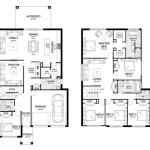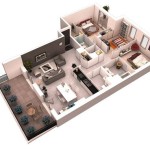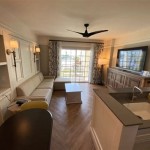How To Make A Bedroom In A Studio Apartment
Studio apartments, known for their open-concept design, often present a unique challenge: the lack of a defined bedroom space. Successfully carving out a sleep sanctuary within the confines of a single room requires careful planning and strategic implementation. This article outlines various methods and considerations for creating a distinct bedroom area in a studio apartment, ensuring both functionality and aesthetic appeal.
The primary goal is to establish a visual and, potentially, physical separation between the sleeping area and the rest of the living space. This separation offers a sense of privacy, reduces visual clutter, and psychologically designates a space for rest and relaxation. Several factors influence the optimal approach, including the apartment's size, layout, natural light sources, and the resident's personal design preferences and budget.
Divide and Conquer: Room Divider Strategies
Employing room dividers is perhaps the most common and versatile method for delineating a bedroom area in a studio. A variety of options exist, each with its own advantages and disadvantages. The choice depends on desired level of privacy, cost, and permanence.
Bookshelves: Strategically placed bookshelves not only create a physical barrier but also provide valuable storage space. These can be arranged to create a solid wall or left partially open to allow light to filter through. The height and width of the bookshelf should be proportionate to the apartment's size. Securing the bookshelves to the wall is crucial to prevent tipping, especially in areas prone to seismic activity or with active pets.
Curtains: Curtains offer a soft and flexible solution. They are relatively inexpensive and easy to install. Opting for blackout curtains provides enhanced privacy and light control, essential for a comfortable sleep environment. Curtains can be hung from a ceiling-mounted track or a tension rod. The fabric choice significantly impacts the overall aesthetic; heavier fabrics offer more sound dampening and visual separation, while lighter fabrics create a more airy and translucent effect.
Screens and Folding Panels: Screens and folding panels are lightweight, portable, and available in a wide range of styles and materials. They can be easily moved or folded away when not needed, offering flexibility in spatial arrangement. The level of privacy provided depends on the screen's opacity and height. Consider the screen's stability, particularly if pets or children are present.
Sliding Doors: For a more permanent and substantial division, sliding doors are an excellent choice. They offer a high degree of privacy and noise reduction. Installation requires some structural modification and is therefore more expensive than other options. Sliding doors can be made of various materials, including glass, wood, and metal, allowing for customization to match the apartment's décor. Ensuring smooth and quiet operation of the sliding mechanism is essential.
Plants: A row of tall, leafy plants can create a natural and visually appealing room divider. This option adds a touch of greenery to the apartment and improves air quality. However, plants require regular maintenance, including watering, fertilizing, and pruning. The effectiveness of plants as a privacy screen depends on their density and height. Choose plant species that thrive in the apartment's lighting conditions.
Maximizing Vertical Space and Storage
Studio apartments often lack sufficient storage space, making it crucial to maximize vertical space. Incorporating storage solutions into the bedroom area helps to keep the living space organized and clutter-free. Thoughtful storage is essential for optimizing limited square footage.
Loft Beds: Loft beds are a space-saving solution that elevates the sleeping area, freeing up floor space for other uses, such as a desk, seating area, or storage. Loft beds are particularly well-suited for apartments with high ceilings. Ensure the loft bed is structurally sound and meets safety standards. Consider the ease of access to the bed; a ladder or staircase should be sturdy and comfortable to use. The height of the loft bed should allow for adequate headroom beneath it.
Storage Beds: Beds with built-in storage drawers or lift-up mechanisms provide valuable storage space for clothing, bedding, and other items. These beds are a practical and discreet way to increase storage capacity without sacrificing aesthetics. Consider the weight capacity of the storage drawers or lift-up mechanism. Ensure the drawers slide smoothly and the lift-up mechanism operates easily and safely.
Wall-Mounted Shelves: Wall-mounted shelves provide additional storage without occupying floor space. They can be used to display books, decorative items, or store folded clothing. Choose shelves that are appropriate for the weight of the items being stored. Install the shelves securely to the wall to prevent them from falling. Arrange the shelves in a visually appealing and functional manner.
Wardrobes and Armoires: Freestanding wardrobes and armoires offer ample storage for clothing and accessories. They can be used to create a physical barrier between the sleeping area and the living space. Choose a wardrobe or armoire that complements the apartment's décor and provides sufficient storage for the resident's needs. Ensure the wardrobe or armoire is stable and secure to prevent tipping.
Creating a Cohesive Design
While establishing a distinct bedroom area is important, maintaining a cohesive design throughout the studio apartment is equally crucial. The bedroom area should complement the overall aesthetic of the living space, creating a harmonious and visually appealing environment. Consistency in color palettes, materials, and furniture styles contributes to a unified look.
Color Palette: Using a consistent color palette throughout the apartment creates a sense of unity. Consider using a neutral color for the walls and floors and incorporating pops of color through accessories and artwork. The bedroom area can feature a slightly different shade of the same color to subtly distinguish it from the rest of the living space. Lighter colors tend to make a space feel larger and more open, while darker colors can create a more intimate and cozy atmosphere. Consider the amount of natural light the apartment receives when choosing a color palette.
Lighting: Adequate lighting is essential for creating a comfortable and functional living space. Incorporate a variety of lighting sources, including ambient lighting, task lighting, and accent lighting. In the bedroom area, consider using dimmable lights to create a relaxing atmosphere. A bedside lamp is essential for reading and other activities. Ensure the lighting fixtures complement the overall design of the apartment.
Furniture Styles: Choose furniture styles that complement each other and create a cohesive look throughout the apartment. Avoid mixing too many different styles, as this can create a cluttered and disjointed appearance. Consider the scale of the furniture; larger pieces can overwhelm a small space, while smaller pieces may look insignificant in a larger space. Arrange the furniture in a way that maximizes space and functionality.
Rugs: Rugs can be used to define different areas within the studio apartment, including the bedroom area. Choose a rug that is appropriately sized for the space and complements the overall décor. A rug can add warmth and texture to the apartment and help to absorb sound.
Artwork and Accessories: Carefully chosen artwork and accessories can add personality and style to the studio apartment. Hang artwork at eye level and choose pieces that complement the color palette and furniture styles. Use accessories sparingly to avoid creating clutter. Arrange the accessories in a visually appealing and functional manner.
In conclusion, creating a bedroom area in a studio apartment requires careful planning and attention to detail. By implementing various room divider strategies, maximizing vertical space and storage, and maintaining a cohesive design, it is possible to transform a single room into a functional and aesthetically pleasing living space.
:max_bytes(150000):strip_icc()/Sliding-Door-Curtain-Studio-Bedroom-587e8e323df78c17b6b94156.jpg?strip=all)
27 Ways To Divide A Studio Apartment Into Multiple Rooms
:max_bytes(150000):strip_icc()/After4-775768-5a849bbfc5542e00370ebf84.jpg?strip=all)
27 Ways To Divide A Studio Apartment Into Multiple Rooms

How To Effortlessly Turn A Room Into Studio Apartment Polda Builders

Creating A Bedroom In Studio Apartment With Doors Barn Door Hardware
:max_bytes(150000):strip_icc()/1-Pegboard-Apartment-via-smallspaces.about.com-56842af75f9b586a9e079d5f.jpg?strip=all)
27 Ways To Divide A Studio Apartment Into Multiple Rooms

5 Ways To Create A Bedroom In Studio Apartment

Ways To Create A Bedroom In Studio Apartment
:max_bytes(150000):strip_icc()/16-Create-Tiny-Zones-587685b63df78c17b653471a.jpg?strip=all)
27 Ways To Divide A Studio Apartment Into Multiple Rooms

7 Tips For Styling A Bed In Studio Apartment

How To Separate A Bedroom In Studio Apartment 46 Ideas Digsdigs








